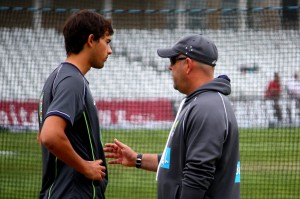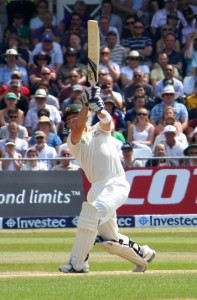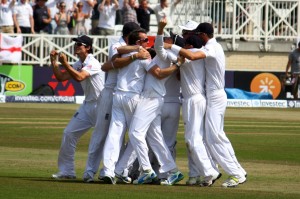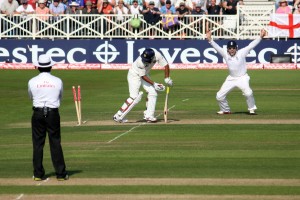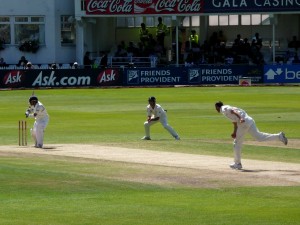Twists and tails as England triumph at Trent Bridge
Monday, July 15th, 2013Boy oh boy. Have we had some cricket these last five days.
From the surprise selection of 19-year-old left-arm spinner Ashton Agar on Wednesday morning, to an England victory by 14 runs – echoes of Edgbaston 2005 – there have been riches aplenty for those of us for whom all those endless previews were starting to meld together into one amorphous mass of reheated churnalistic chip-wrap.
A number eleven breaking batting records that have stood since the Golden Age of Trumper and Armstrong; a thick edge that somehow goes unsighted by a respected umpire and the howls of controversy that followed; a side written off even before landing on these shores refusing to roll over and die, and it’s fair to say none of the previews led us to expect anything like this.
I was fortunate to be at Trent Bridge on the first and last days: on the way to the ground on Sunday we passed the Australian team bus, complete with Boof-Shrek doll stuck to its windscreen, and we saw them bowled out via the decision review system and the thinnest of thin edges as 17,000 fans held their breath in the broiling heat before erupting in relief and celebration – or despair, if you were one of the many travelling Aussie fans who’d helped ensure a five-day sellout. It was magnificent. It was crazy. It was exhausting, as Haddin and Pattinson chewed away the total required while the crowd chewed down its fingernails. It occurred to me, after everything that had happened the previous four days, that cricket should occupy its own temporal frame of reference, the way one human year equates to seven dog years, or the time it takes Jupiter in terms of Earth days to accomplish a circuit around the sun.
I kind of had an inkling it would go this way, watching the Australians warming up on the outfield before the start of play. Despite (or perhaps because of) the highlights of Day Four playing on the big screen behind them, Darren Lehmann made sure to keep his charges’ attention focused and their spirits high, organising a team huddle, taking the lead in a boisterous kickabout, larking about and playing the clown, but also having a quiet word with individual players, most notably Ashton Agar, who received the benefit of Boof’s wisdom during a break in the high jinks. They looked calm, relaxed, and united as a team, with genuine fondness and respect for their new coach. They did not look like a side who thought they were beaten.
Whatever Lehmann said to Agar, it worked, as, promoted to number eight, he continued where he’d left off after that fairy-tale knock of 98 that gave Australia a new hero to wake up to along with its Friday morning cornflakes. (That day, Agar’s emergence as a fully formed Test cricketer, was also the day of Ricky Ponting’s 169*, for Surrey at the Oval, in his last ever first class innings – one in, one out.)
Agar provided his partner at the other end, Brad Haddin, with able support in a 43-run, 24.4-over, partnership that soaked up the deliveries sent down by a bowling attack that had already spent a long day in the field and with an old ball that was doing nothing. Such was the epic nature of this match it was easy to view these two through the lens of heroic archetype, the stuff that myth is made of: battled-hardened veteran and youthful recruit, master and apprentice, Pat Garrett and Billy the Kid before that whole betrayal and manhunt thing.
The ability of the human body to withstand the rigours of extreme exertion while coupled with the will to win can produce greatness. That greatness manifested in Jimmy Anderson, steaming in from the Radcliffe Road end with a new ball that had all four remaining batsmen’s names written on it. Agar’s was the first wicket of the day to fall, Haddin’s the last – after a lunchbreak in which Australia were nine wickets down with 20 needed to win. Food may have been the last thing on the minds of the two teams during those 40 minutes. By 2:30 it was all over. Anderson, with 5-73, and ten wickets in the match, looked so exhausted at the Man of the Match presentation afterwards, he could barely string two words together.
It would take a book, and considerably more bandwidth, to describe all the extraordinary things that happened in this Test match. Along with Agar’s sparkling debut, Peter Siddle again proved he is the heart as well as the backbone of Australia’s attack with his fourth Ashes five-for on Day One as England collapsed after winning the toss. Ian Bell’s match- and career-defining innings of 109 came when England desperately needed it; a true-grit ton from a man often criticised for scoring soft runs when someone else has already done the hard graft. Last but not least, there was James Anderson’s unplayable delivery to Michael Clarke on the first day, and his wrecking-ball spell on the last.
And then there was the decision review system, or more specifically, its shortcomings. In reality, it was more human error than failure of technology that caused the controversies, and while the referral by England that saw the back of Haddin and the end of the match was called controversial by some, in that instance it did exactly what it was supposed to – provide clear evidence, using the technology available, to overturn a wrong decision. True, there will be many “what-ifs” as a result of missed deflections, replays that showed evidence contrary to the decision given, and simple umpiring error; but what-ifs, of one variety or another, are what make all matches that linger long in the memory.
If Stuart Broad had walked after edging Ashton Agar to slip, England likely would have lost. If Agar, on 6, had been given out stumped England probably would have wrapped this up on Saturday.
Instead it came down to this: a morning session extended by half an hour, and then, on the restart, the simple equation of one wicket, twenty runs and a tail-end partnership that nearly made the difference.
Some of the previews for Trent Bridge were a little too dismissive of Australia’s appetite for this fight. I’m guessing the previews for Lord’s will make for slightly racier reading.
